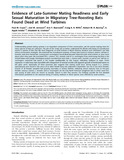| dc.contributor.author | M. Cryan, Paul | |
| dc.contributor.author | W. Jameson, Joel | |
| dc.contributor.author | Baerwald, Erin F. | |
| dc.contributor.author | Willis, Craig K. R. | |
| dc.contributor.author | Barclay, Robert M. R. | |
| dc.contributor.author | Snider, E. Apple | |
| dc.contributor.author | Crichton, Elizabeth G. | |
| dc.date.accessioned | 2016-12-08T23:26:18Z | |
| dc.date.available | 2016-12-08T23:26:18Z | |
| dc.date.issued | 2012-10 | |
| dc.identifier.citation | Cryan, P. M., J. W. Jameson, E. F. Baerwald, C. K. R. Willis, R. M. R. Barclay, et al. "Evidence of Late-Summer Mating Readiness and Early Sexual Maturation in Migratory Tree-Roosting Bats Found Dead at Wind Turbines." PLoS ONE 7(10) (2012): e47586. DOI:10.1371/journal.pone.0047586. | en_US |
| dc.identifier.issn | 1932-6203 | |
| dc.identifier.uri | http://hdl.handle.net/10680/1257 | |
| dc.description.abstract | Understanding animal mating systems is an important component of their conservation, yet the precise mating times for many species of bats are unknown. The aim of this study was to better understand the details and timing of reproductive events in species of bats that die most frequently at wind turbines in North America, because such information can help inform conservation strategies. We examined the reproductive anatomy of hoary bats (Lasiurus cinereus), eastern red bats (L. borealis), and silver-haired bats (Lasionycteris noctivagans) found dead beneath industrial-scale wind turbines to learn more about when they mate. We evaluated 103 L. cinereus, 18 L. borealis, and 47 Ln. noctivagans from wind energy facilities in the United States and Canada. Histological analysis revealed that most male L. cinereus and L. borealis, as well as over half the Ln. noctivagans examined had sperm in the caudae epididymides by late August, indicating readiness to mate. Testes regression in male hoary bats coincided with enlargement of seminal vesicles and apparent growth of keratinized spines on the glans penis. Seasonality of these processes also suggests that mating could occur during August in L. cinereus. Spermatozoa were found in the uterus of an adult female hoary bat collected in September, but not in any other females. Ovaries of all females sampled had growing secondary or tertiary follicles, indicating sexual maturity even in first-year females. Lasiurus cinereus, L. borealis, and Ln. noctivagans are the only North American temperate bats in which most firstyear young of both sexes are known to sexually mature in their first autumn. Our findings provide the first detailed information published on the seasonal timing of mating readiness in these species most affected by wind turbines. | en_US |
| dc.description.sponsorship | This research was funded in part by the U.S. Fish and Wildlife Service, the United States Geological Survey, grants to CW from the Sustainable Development Innovation Fund of Manitoba Conservation, grants to CW and RB from the Natural Science and Engineering Research Council (NSERC, Canada), and funding to RB and EB from Bat Conservation International, the University of Calgary’s Institute for Sustainable Energy, Environment and Economy, TransAlta, Enmax, Suncor, and Alberta Wind Energy. | en_US |
| dc.description.uri | http://journals.plos.org/plosone/article?id=10.1371/journal.pone.0047586 | |
| dc.language.iso | en | en_US |
| dc.rights | info:eu-repo/semantics/openAccess | |
| dc.subject | Hoary bat -- Anatomy | en_US |
| dc.subject | Eastern red bat -- Anatomy | en_US |
| dc.subject | Silver-haired bat -- Anatomy | en_US |
| dc.title | Evidence of Late-Summer Mating Readiness and Early Sexual Maturation in Migratory Tree-Roosting Bats Found Dead at Wind Turbines | en_US |
| dc.type | Article | en_US |
| dc.identifier.doi | 10.1371/journal.pone.0047586 | |

